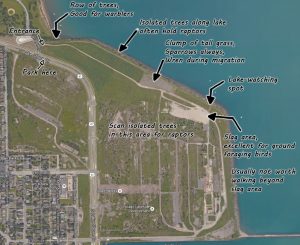Tag Archives: Le Conte’s Sparrow
Waukegan Beach
Nestled amongst an archaic industrial backdrop, Waukegan Beach is one of the premier lakefront birding sites in Lake County. Historically, this site has hosted quite a few state rarities, including Tricolored Heron, Arctic Tern, and Mountain Bluebird. In the fall and winter months, the northernmost pier has been the most reliable spot in the state to find a Purple Sandpiper. It almost strictly a migratory bird stopover site, with very few notable breeders. The summer months are dominated by beach goers, and unless you get there early, a fee to enter the beach. Birding Waukegan can be broken into several categories: beach, dunes, park, harbor.
The beach proper is best birded by heading north on the shoreline from the northern pier. The half mile stretch of beach to Greenwood Ave is a great place in the spring and summer to pick up migrating shorebirds. In April, it is a great spot for Piping Plovers. Other notable shorebirds seen in fall/spring migration include Baird’s Sandpiper, White-rumped Sandpiper, Semipalmated Sandpiper, Dunlin, Willet, American Avocet, Marbled Godwit, Semipalmated Plover, Black-bellied Plover, American Golden-Plover, and Red Knot. In spring, terns are easily seen flying over the lake with both Common and Forster’s being numerous. Also, Bonaparte’s Gulls are readily seen in season while walking the beach, though not in their previous numbers.
As mentioned earlier, the piers are, with luck, a great spot to find Purple Sandpiper. In migration, Ruddy Turnstones are seen almost annually on the piers, too. In winter, this has been a historical site to find Harlequin Duck. Off the piers (northern or “Government” Pier) on a fall day with stiff NE winds, is a great place for lake watching. All three scoter species have been found alongside Long-tailed Ducks and the other common divers.
The dunes adjacent to the beach are a great place to hike during migration. Any part of the dunes near water can kick up Nelson’s and Le Conte’s Sparrows. An early morning hike can include hunting Northern Harriers and flushed Short-eared Owls. Swarms of swallows course over the marshland, with all the regular occurring species seen in good numbers. The fall of 2012 included a November sighting of Cave Swallow. Scrubbier habitat near the beach parking lot can hold large quantities of migrating passerines on any spring/fall day. Always worth checking this area.
The park just west of the swimming beach, locally known as the “Magic Pines,” can be migrant trap. Notable species seen during migration include Northern Mockingbird, Yellow-bellied Flycatcher, Canada Warbler, Mourning Warbler, and Clay-colored Sparrow. Almost any migratory passerine can be found here on the right day. Like most lakefront sites, this can also be a great place to see high counts for a species.
The harbor is the place to look for ducks that enjoy sheltered waters. During migration and winter, look for Horned Grebe, Pied-billed Grebe, Hooded Merganser, Wood Duck, Gadwall, Bufflehead and Common Goldeneye. To bird the harbor, it is best to walk along Government Pier, parking in the marina parking lot. It’s always worth scanning from the end of government pier. Most recently, a Western/Clark’s Grebe was spotted there. Snowy Owls have been found on the harbor docks in winter, as well as on the end of the piers in good years. As the harbor freezes over, gulls congregate in small/medium numbers. Despite not having the highest individual counts, the seven “regular” species have been seen.
Rollins Savanna
The marshy sloughs can be accessed from either the Washington St. parking area on the south, or the Drury Lane parking lot on the west (shorter walk from Drury Ln.) Birds breeding here include Yellow-headed Blackbird, American and Least Bittern, Sandhill Crane, Henslow’s, Savannah and Grasshopper Sparrows, Bobolink and other expected prairie species. In the fall, the wet areas around the slough edges can be excellent for sparrows, especially Nelson’s and Le Conte’s. Short-eared Owls can be seen here in most years from October to December and sometimes through the winter. American Kestrel and Northern Harrier are regulars during winter and during spring and fall, the ponds at Rollins are loaded with all manner of dabbling ducks. It’s the best spot in the area for Northern Pintail. In winter it is not unusual to get Lapland longspur, Horned Lark, and Snow Bunting here as well.
View Illinois Birding Map in a larger map
IBSP Hawkwatch
The Illinois Beach State Park Hawkwatch has someone station at the picnic shelter (blue point on map) almost every day of the fall. Moderate-to-strong west winds are best, and depending on the date, many species of migrating raptors can be seen including: Sharp-shinned and Coopers Hawks, Northern Goshawk, Osprey, Bald and Golden Eagle, Rough-legged, Red-shouldered, Broad-winged Hawks, Merlin and Peregrine Falcon. Interestingly, Mississippi Kites have been seen here regularly in August and September, with as many as 3 individuals seen at one time.
The prairie grasses around the shelter are a reliable place in September and early October for Nelson’s and Le Conte’s Sparrows.
Rarities seen here include Ferruginous Hawk, Swainson’s Hawk, Swallow-tailed Kite, Gyrfalcon, Common Raven, Fork-tailed Flycatcher and Say’s Phoebe.
View Illinois Birding Map in a larger map
